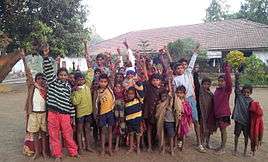India tribal belt
India's tribal belt refers to contiguous areas of settlement of tribal people of India, that is, groups or tribes that remained genetically homogenous as opposed to other population groups that mixed widely within the Indian subcontinent.
Northwest India
The Tribal Belt of Northwest India includes the states of Rajasthan and Gujarat. The tribal people of this region have origins which precede the arrival of the Ancestral North Indians and are linked to the Ancestral South Indians. these people are thought to stem back to the Harappan civilization of the Indus Valley, the oldest traceable civilization of the Indian subcontinent which flourished between 3500BC and 2500BC.
The tribes of north-west India were once strongly matrilineal societies. The changing fates and fortunes of these people has caused a gradual evolution to a more patriarchal code of living. These days the tribal societies generally follow the rule of patriliny, but there remain many examples of organised matriarchy in existence in the tribal zones to this day. It is the women who organise matters such as relationships and marriages, the inheritance of land, and the distribution of wealth.
South Gujarat Tribal Belt
The Southern Tribal Belt, popularly known as 'Dang', a forbidden territory covered with thick forests in the region of the South Gujarat. Located on the foothills of the Sahyadri range of mountains, it has green pastures, narrow roads, deep valleys, and wild animals. During the monsoon one can see water springs and a green carpet of diverse flora/fauna.
Spread across the lush green region of South Gujarat Tribal Belt said to be Kashmir of Gujarat. live the tribes of Bhil, Kholcha, Bhel, Nayaka, Koknas, Vedch, Gamits, Warlis, and Chaudaris.

Dakshin Gujarat Adivasi Sevamandal is an NGO founded by the Gandhian philosopher Premshankar Bhatt and his daughter Urmillaben Bhatt in 1948 to spread education in the deep forest of the South Gujarat Tribal Belt. It is registered as a trust under the Bombay Trust Act. It provides education to South Gujarat Tribals through a resident school (Ashramshalla) which offers free education, lodging and boarding. The Tribal Belt of Gujarat today has the highest literate tribal population in India.[1]
Central & Eastern Tribal Belt India
The Central India Tribal Belt stretches from Gujarat in the west up to Assam in the east across the states of Madhya Pradesh, Chhattisgarh and Jharkhand. It is among the poorest regions of the country. Over 90% of the Belt's tribal population is rural, with primitive agriculture.[2]
See also
- Adivasi ("Scheduled tribes")
- List of Scheduled Tribes in India
- Eklavya Model Residential School
References
- ↑ "Dakshin Sevamandal Tribal Ashram". Accessed 8 September 2017.
- ↑ "Central India Initiative"